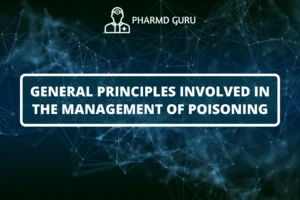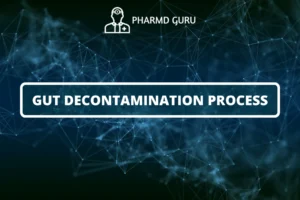Elimination enhancement methods aim to expedite the removal of toxins by increasing their elimination through various routes.
SCROLL DOWN TO THE BOTTOM OF THE PAGE FOR ACTUAL NOTES
TABLE OF CONTENTS:
- Introduction
- Importance of Elimination Enhancement
- Methods of Elimination Enhancement
- 3.1. Urinary Alkalinization
- 3.2. Forced Diuresis
- 3.3. Hemodialysis
- 3.4. Hemoperfusion
- 3.5. Exchange Transfusion
- Considerations and Precautions
Introduction
In cases of poisoning or toxic exposures, enhancing the elimination of toxic substances from the body can be crucial to prevent further harm and promote recovery. Elimination enhancement methods aim to expedite the removal of toxins by increasing their elimination through various routes. This article explores the importance of elimination enhancement, different methods employed, and important considerations surrounding these interventions.
Importance of Elimination Enhancement
Enhancing the elimination of toxic substances from the body is important for several reasons:
- Reduction of Toxicity: By increasing the elimination of toxic substances, their concentration in the body can be reduced, minimizing the potential for ongoing harm to organs and tissues.
- Shortening the Duration of Action: Enhanced elimination helps to shorten the duration of toxic effects by rapidly eliminating the substances responsible for poisoning.
- Minimization of Organ Damage: Many toxic substances can cause damage to organs such as the liver, kidneys, or central nervous system. Enhanced elimination can help prevent or minimize further injury to these organs, allowing them to recover more effectively.
- Facilitation of Recovery: By expediting the removal of toxins, elimination enhancement methods can facilitate the overall recovery process and improve patient outcomes.
Methods of Elimination Enhancement
Several methods are available to enhance the elimination of toxic substances from the body. The choice of method depends on factors such as the specific toxin involved, its physicochemical properties, the patient’s condition, and the availability of resources and expertise. The following are some commonly used methods:
3.1. Urinary Alkalinization
Urinary alkalinization aims to increase the pH of urine, which can enhance the elimination of certain acidic toxins that are excreted primarily in the urine. Key points about urinary alkalinization include:
- Mechanism: Alkalinization of urine is achieved by administering substances such as sodium bicarbonate or acetazolamide to increase urinary pH.
- Indications: Urinary alkalinization is often employed in cases of salicylate poisoning, methotrexate toxicity, or certain cases of phenobarbital overdose.
- Monitoring: Close monitoring of urinary pH, electrolyte levels, and the patient’s clinical response is necessary during urinary alkalinization.
3.2. Forced Diuresis
Forced diuresis involves increasing urine production to enhance the elimination of water-soluble toxins through the kidneys. Key points about forced diuresis include:
- Procedure: Intravenous fluids are administered to maintain a high urine output, typically above 2 mL/kg/h in adults and higher in children.
- Indications: Forced diuresis may be considered in cases of poisoning with substances such as methanol, ethylene glycol, or lithium.
- Monitoring: Monitoring urine output, electrolyte levels, and the patient’s overall fluid balance is essential during forced diuresis.
3.3. Hemodialysis
Hemodialysis is a highly effective method for eliminating toxins from the bloodstream by filtering the blood through a dialysis machine. Key points about hemodialysis include:
- Procedure: Hemodialysis involves the passage of the patient’s blood through a dialysis machine that removes toxins and excess fluids. The cleansed blood is then returned to the body.
- Indications: Hemodialysis may be recommended in cases of severe poisoning, such as with certain drugs, renal failure, or substances that are poorly removed by other methods.
- Monitoring: Close monitoring of the patient’s clinical status, blood chemistry, and dialysis adequacy is necessary during hemodialysis.
3.4. Hemoperfusion
Hemoperfusion involves passing the patient’s blood through an adsorbent material to remove toxins. Key points about hemoperfusion include:
- Procedure: Blood is circulated through a cartridge containing an adsorbent material, such as activated charcoal or resin, which adsorbs and removes toxins.
- Indications: Hemoperfusion may be considered in specific cases, such as poisoning with certain drugs or toxins that are well adsorbed by the chosen adsorbent material.
- Monitoring: Monitoring the patient’s clinical response, blood chemistry, and the effectiveness of toxin removal through hemoperfusion is important.
3.5. Exchange Transfusion
Exchange transfusion involves replacing a patient’s blood with donated blood or a blood product to eliminate toxins. Key points about exchange transfusion include:
- Procedure: Blood is withdrawn from the patient, and either whole blood or specific blood components are transfused back into the patient, allowing for the removal of toxic substances.
- Indications: Exchange transfusion may be considered in cases of severe poisoning or when other methods of toxin elimination are insufficient.
- Monitoring: Close monitoring of the patient’s clinical response, blood chemistry, and the overall safety of the transfusion process is necessary.
Considerations and Precautions
When employing elimination enhancement methods, healthcare professionals should consider the following:
- Individual Assessment: The choice of elimination enhancement method should be based on the specific toxin involved, its properties, the patient’s condition, and the availability of resources and expertise.
- Monitoring: Continuous monitoring of the patient’s clinical status, vital signs, laboratory parameters, and the effectiveness of toxin removal is essential during elimination enhancement interventions.
- Complications: Each method of elimination enhancement carries its own risks and potential complications. These should be weighed against the potential benefits and considered on an individual basis.
- Collaboration: Collaboration with toxicology experts, nephrologists, or other specialists is crucial to ensure appropriate and effective management of elimination enhancement methods.
ACTUAL NOTES




